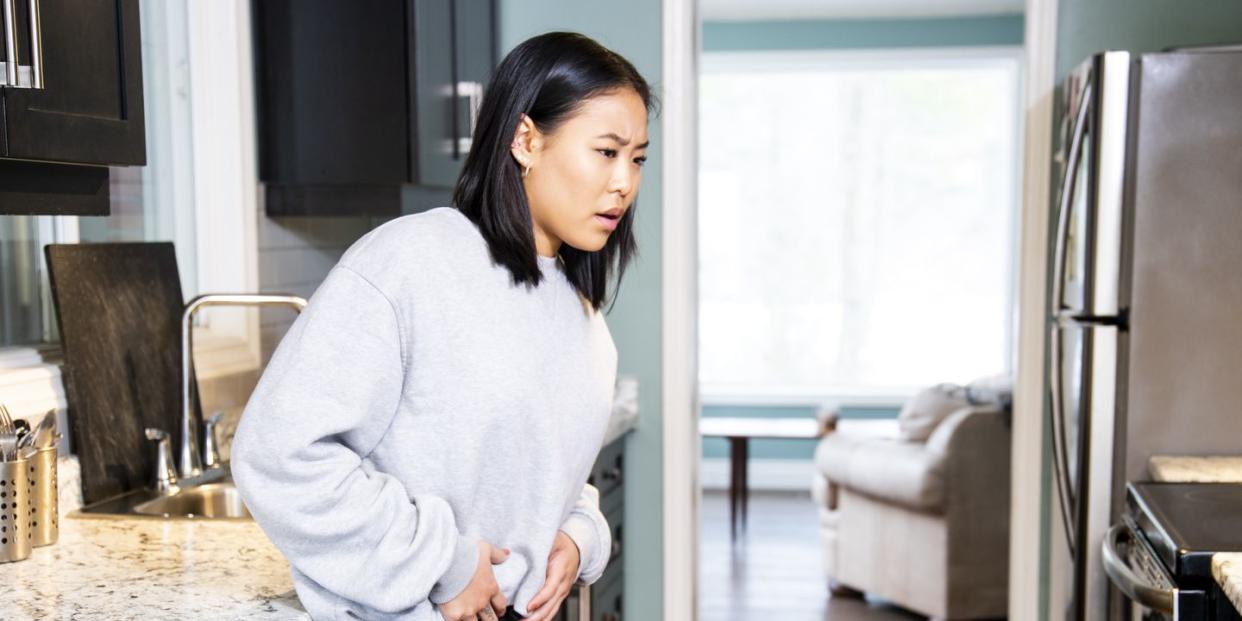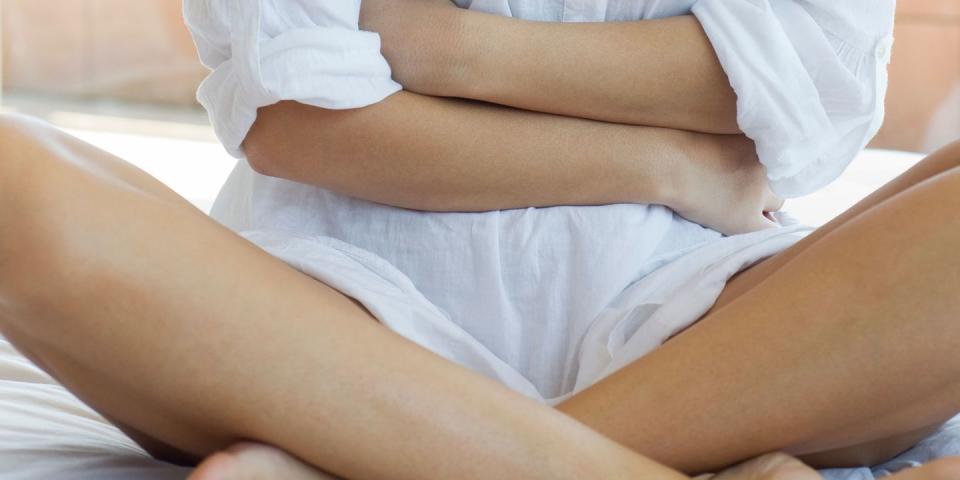What's causing your lower abdominal pain?

Lower abdominal pain in women generally refers to pain, discomfort or cramps below the belly button. From appendicitis to period cramps, there are a number of potential causes for lower abdominal pain in women and the right treatment depends on the correct diagnosis.
Dr Juliet McGrattan looks at 15 possible causes of lower abdominal pain in women, so you know when to reach for the hot water bottle or when to call your doctor:
What is lower abdominal pain?
When we talk about lower abdominal pain, we generally mean pain that you feel below the level of your belly button. It can come from any of the tissues and organ systems in that area, which is why it can be very confusing. Pain which is very low down is termed pelvic pain but we’ll be including it as lower abdominal pain for this guide.
Describing your lower abdominal pain
When a doctor asks you about your pain, they will want to know where exactly you are feeling the pain. This can be a useful indicator of what the cause might be.
They’ll also want to know how long you’ve had the pain, the severity and the nature of the pain; is it coming or going or is it continuous? They will ask you to describe how the pain feels, is it sharp, dull, crampy or burning for example.
Associated symptoms such as diarrhoea, vomiting and urinary symptoms can all help to distinguish the cause so your doctor will question you about these as well.
15 possible causes of lower abdominal pain in women
We’ll explore the causes of lower abdominal pain by their location to make it easier to work out what is causing your pain.
Pain around the belly button
If you experience pain around the belly button (peri-umbilical) it could be one of the following:
• Early appendicitis
Inflammation of the appendix is often initially felt around the belly button. It may come and go and gradually move to the right side. It gets more severe over 24 hours and is worse on movement. You may feel nauseated, have slight loose stools and a temperature. Surgery is often required to remove an inflamed appendix so don’t wait at home if you think this may be the diagnosis.
• Stomach ulcers
Conditions of the stomach lining such as inflammation (gastritis) or ulcers may be felt in the centre of your abdomen. The pain is often burning in nature. Nausea, indigestion, belching and even vomiting are common. Blood in the vomit or black, tar-like stools are worrying signs and need urgent assessment. Treatment to stop acid production and ease pain are required so see your doctor.

Pain just above the pubic bone
If you experience pain just above the pubic bone (supra-pubic) it could be one of the following:
• Bladder pain
Bladder pain is generally a low central pain. Cramping and burning during or after passing urine might indicate an infection. With a urine infection you might need to go for a wee more often, notice blood in your urine and feel tired and sick. If your symptoms aren’t settling with plenty of fluids, then you need to see your doctor for possible antibiotics. Bladder stones can cause pain in this area too with a sharper, more severe pain and difficulty passing urine.
• Period pain
Crampy, low, central pain is typical of menstrual pain (dysmenorrhoea) although it may radiate across to the sides too. Period pain can start in the days leading up to bleeding commencing but usually eases up after a few days of blood loss. Pain killers from the pharmacist, a hot water bottle and gentle exercise can all help.
• Pelvic Inflammatory Disease (PID)
An infection in your womb, tubes or ovaries can be quite mild with occasional pain or more severe with intense pain and fever. Other symptoms include discoloured vaginal discharge, bleeding unexpectedly and pain when having sex (dyspareunia) or passing urine. A quarter of cases are due to a sexually transmitted infection so a full sexual health screen is needed if this is a possibility. Attend your local sexual health clinic or GP if you think you have PID.
Pain on one side
Sometimes low abdominal pain is felt on one side. It can be anywhere from just beside of your belly button, right down to your groin, and could be one of the following:
• Ovulation pain
Also known as mittelschmerz, this sharp pain can occur when your ovary is releasing an egg in the middle of your menstrual cycle, so about two weeks before your period. It may be on the right or the left side, depending on which ovary is releasing an egg that month. Although it can be severe, it is usually short lived and is normal and not harmful.
• Ovarian cysts
Ovarian cysts are rarely painful. Most will go away on their own and it’s only if they become particularly large, twist or rupture that they produce pain. You might experience bloating, pain during sex or need to keep passing urine frequently. Thankfully only a small minority of ovarian cysts are cancerous and this is usually in women who have been through the menopause. You should see your doctor however if you think you may have an ovarian cyst.
• Ectopic pregnancy
This is where a fertilised egg doesn’t make it as far as the womb and tries to grow a foetus in the fallopian tube. The pregnancy cannot continue and surgery is often required to remove it. If left untreated ectopic pregnancy can pose a threat to the mother’s life as well as her future fertility. If you have low one-sided abdominal pain and have missed your period or think you may be pregnant then you should see a doctor as soon as possible.

• Endometriosis
Tissue from the lining of the womb (endometrium) is sometimes found elsewhere in the abdomen and pelvis and causes pain when it bleeds during menstruation. This pain may be central and generalised but as the ovary and fallopian tubes are common sites for endometriosis then pain is often one sided. Treatments include pain killers, hormonal therapies and surgery.
• Appendicitis
As mentioned above, the pain from appendicitis can start centrally but usually settles low down on the right hand side of the abdomen where the appendix is located. It hurts to press in this area and is also worse when you cough, sneeze or move.
• Pyelonephritis
Infection in a kidney gives pain on one side which may originate from or spread through to your back. You may have urinary symptoms such as pain on weeing, have blood in your urine and feel generally unwell. It’s common to feel nauseated, vomit and have a high temperature. These infections are usually bacterial and require antibiotics so don’t delay seeing your doctor.
• Muscular pain
It’s easy to forget that a simple muscle strain can cause pain in the abdomen. The pain can be quite severe when the muscle is moved so consider it if you have been working out or the pain has a muscular feel to it. Warm baths and pain killers will usually settle muscular pains.
Generalised pain
Lots of conditions produce more of an all over pain which doesn’t seem to focus on one location, and could be one of the following:
• Constipation
A common cause of abdominal pain and often associated with nausea, loss of appetite and bloating. The pain is often all over but may be felt on the left hand side where the large bowel descends to the rectum. Treatment involves drinking plenty of fluids, taking exercise and eating fibrous foods. Speak to your pharmacist about laxatives if you are struggling to get your bowels working.
• Irritable Bowel Syndrome (IBS)
Pain from IBS can be anywhere in your abdomen and is often associated with bloating, constipation or diarrhoea. It can be constant or colicky (in waves). IBS is a long term condition and treatment focuses on spotting triggers such as stress and learning to manage the condition through diet and a healthy lifestyle.
• Gastroenteritis
Infections of the bowel such as viruses and food poisoning can cause generalised abdominal pain. It can be a dull ache but often crescendos and cramps up prior to episodes of diarrhoea, vomiting or both. Most bouts of gastroenteritis settle in a few days and the priority for treatment is to avoid dehydration so small amounts of fluids often is advised. If you are concerned you are getting dehydrated or your symptoms are getting worse or not settling after a week then see your doctor.
Abdominal pain examination and investigations
Your doctor will have a good idea as to what might be causing your pain after listening to your description and asking questions. They will usually examine your abdomen too to see if there is any pain on pressing on certain areas of your tummy and to check for any lumps.
They may be able to give you a diagnosis and recommend treatment but if any further clarification is needed then further tests will be arranged. These will vary according to what condition is suspected but may involve:
Taking urine, stool or blood samples
Taking vaginal swabs
Arranging a scan of your abdomen
Possibly referring you to a specialist
It can be a tricky business figuring out exactly what the cause of lower abdominal pain is so do make an appointment if you are concerned and always go back to your doctor if your symptoms aren’t resolving.
When to see a doctor for lower abdominal pain
Rather than trying to diagnose your own pain, if you have any of the following symptoms then see your doctor as soon as possible:
Severe pain
Pain that continues to get worse
A high temperature
Blood in your poo – either fresh or black and smelly
Pain when you are pregnant or think you could be
Inability to walk around due to the pain
Recurrent vomiting especially if there is blood in your vomit
A persistent change in your bowel habit
Last updated: 18-08-2020
You Might Also Like


